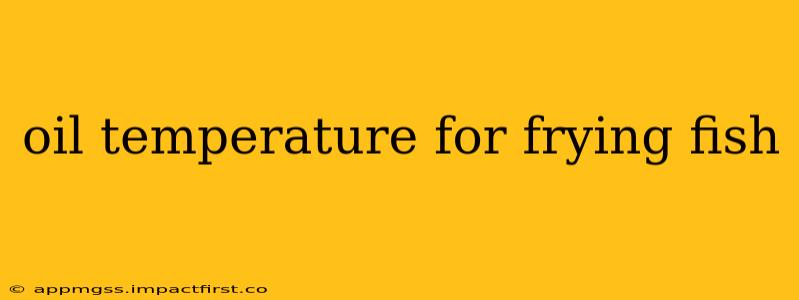Frying fish is a culinary art that, when mastered, delivers incredibly crispy, golden-brown results. But achieving that perfect texture hinges on one crucial factor: the oil temperature. Getting it wrong can lead to soggy, greasy fish or even burnt offerings. This guide will explore the ideal oil temperature for frying fish, addressing common questions and concerns.
What is the ideal oil temperature for frying fish?
The optimal oil temperature for frying fish is generally between 350°F (175°C) and 375°F (190°C). This temperature range ensures that the fish cooks quickly and evenly, creating a crispy exterior while keeping the inside moist and flaky. Using a thermometer is crucial for accuracy; relying on visual cues alone can be misleading.
How do I know if my oil is the right temperature?
There are a few ways to check your oil temperature:
- Thermometer: The most reliable method is to use a deep-fry thermometer. Simply clip it to the side of the pan and monitor the temperature as the oil heats.
- Breadcrumb Test: Drop a small piece of breadcrumb into the oil. If it sizzles and browns within 15-20 seconds, the oil is ready. If it browns too quickly, the oil is too hot; if it takes longer, the oil is too cool.
- Visual Cue (Less Reliable): The oil should shimmer slightly and have a gentle, consistent flow. However, this method is less accurate and should only be used in conjunction with another method.
What happens if the oil temperature is too low?
If the oil temperature is too low (below 350°F), the fish will absorb more oil, resulting in a greasy, soggy texture. The cooking time will also be significantly longer, potentially leading to overcooked, dry fish.
What happens if the oil temperature is too high?
If the oil temperature is too high (above 375°F), the outside of the fish will burn before the inside is cooked through. This results in a charred exterior and a raw interior, a far cry from the desired crispy and flaky result.
What type of oil is best for frying fish?
Several oils work well for frying fish, each with its own advantages:
- Vegetable Oil: A neutral-flavored and widely available option.
- Canola Oil: Similar to vegetable oil, with a high smoke point.
- Peanut Oil: Has a high smoke point and a slightly nutty flavor that complements some fish.
Can I reuse frying oil for fish?
While you can reuse frying oil, it's generally not recommended more than once or twice. Repeated use lowers the smoke point and can impart off-flavors to your food. Plus, the oil will absorb the flavors and potentially particles from the previously fried fish.
How do I safely dispose of used frying oil?
Never pour used frying oil down the drain, as it can clog your pipes. Allow the oil to cool completely, then pour it into a sealed container and dispose of it according to your local regulations. Many recycling centers accept used cooking oil.
By following these tips and maintaining the correct oil temperature, you'll be well on your way to creating perfectly fried fish—crispy, golden, and utterly delicious! Remember, a reliable thermometer is your best friend in this process.
